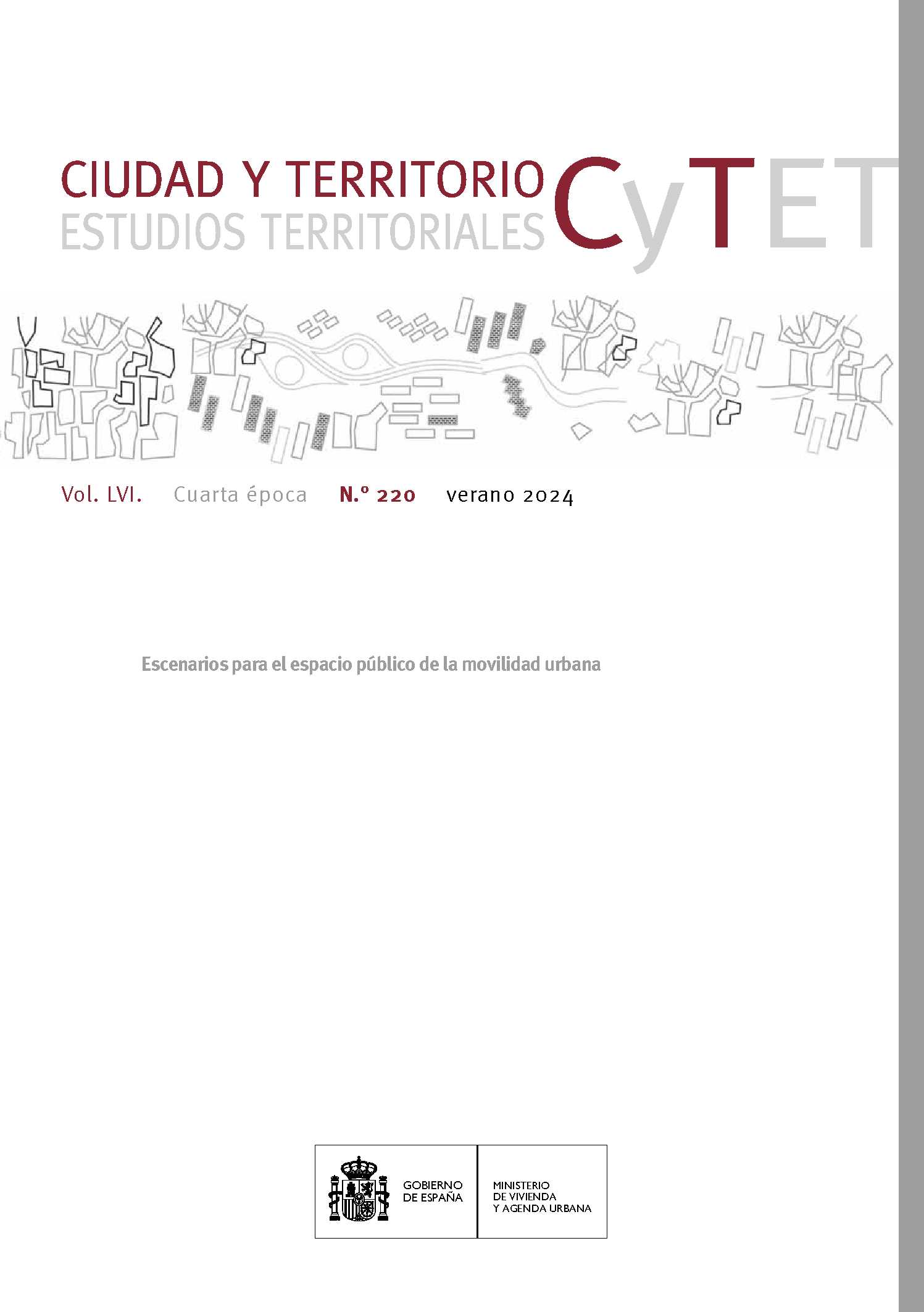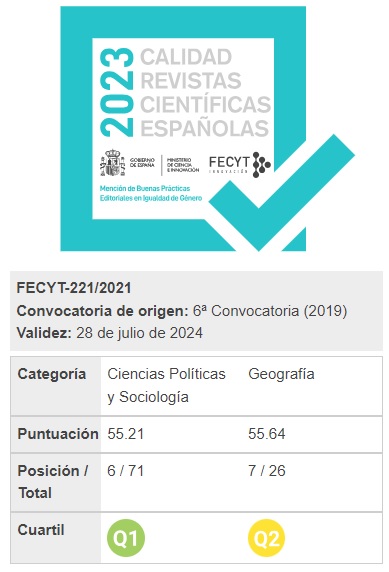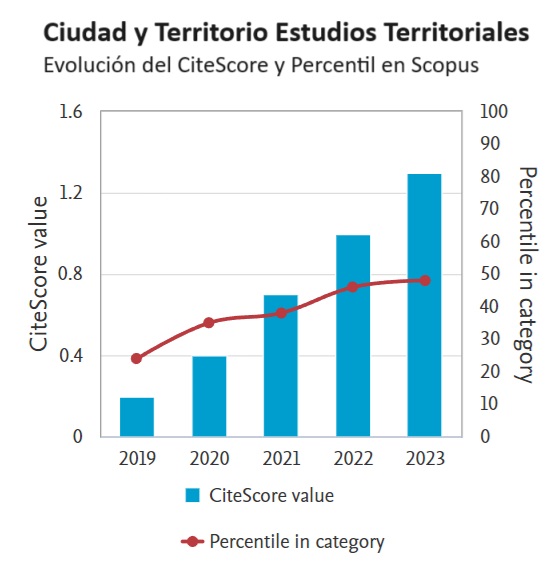Model for the integration of constructions into the urban environment: Plaza Elíptica (Madrid)
DOI:
https://doi.org/10.37230/CyTET.2024.220.19Keywords:
Urban Environment, Intermodal transportation hub, Plaza Elíptica, MadridAbstract
The current challenge for cities is focused on sustainability and this will require a great pact to find positive synergies between territories. Reciprocity between urban environments and society means that the latter must be able to understand what the city needs and that citizens must identify the city scenario they want. With regard to the configuration of public space, the analysis of urban transport projects is crucial because of their great potential to influence the configuration of cities. In this article, we propose to analyse a model, originally designed for the integration of projects in the non-urban environment, for urban environments. The aim is to systematise any activity that allows the planner, designer or manager to follow integration criteria. The integration criteria are also valid and reasonable questions to be asked for urban environments, since in most cases projects implemented in the city are mirrors of activities carried out in the non-urban environment. In particular, the case of the Plaza Elíptica Transport Interchange in Madrid is studied, and it turns out to be a project integrated in the urban environment to which it belongs, as it responds positively to the criteria of the model. Its infrastructure is a reasonable activity and is correctly located.
Downloads
References
Culture Action Europe (2017): Implementing Culture within the Sustainable Development Goals. The role of culture in Agenda 2030. https://cultureactioneurope.org/files/2019/09/Implementing-Culture-in-Sustainable-Development-Goals-SDGs.pdf
GÓMEZ-OREA D. (1993): Ordenación Del Territorio. Una Aproximación Desde El Medio Físico. Madrid: Instituto Tecnológico GeoMinero de España.
GÓMEZ-OREA D. (2002): Evaluación de Impacto Ambiental: Un Instrumento Preventivo Para La Gestión Ambiental. Madrid: Mundi-Prensa Libros.
GÓMEZ-OREA D. & GÓMEZ-VILLARINO M. (2007): Consultoría e Ingeniería Ambiental. Planes, Programas, Proyectos, Estudios, Instrumentos de Control Ambiental, Dirección y Ejecución Ambiental de Obra, Gestión Ambiental de Actividades. Madrid: Ediciones MP.
GÓMEZ VILLARINO M. & GÓMEZ VILLARINO T. & GÓMEZ-OREA D. (2013): El paisaje urbano: una aproximación a sus componentes básicos para su inserción en planes y proyectos. Ciudad y territorio: Estudios territoriales 175: 9–25.
IBARRA-BENLLOC P. (2017): Una propuesta metodológica para el estudio del paisaje integrado. Geographicalia 30: 229–242. DOI: https://doi.org/10.26754/ojs_geoph/geoph.1993301820
NAVARRO I. & GALILEA P. & HIDALGO R. & AL. (2018): Transporte y su integración con el entorno urbano: ¿cómo incorporamos los beneficios de elementos urbanos en la evaluación de proyectos de transporte? Eure 44(132): 135–153. DOI: http://dx.doi.org/10.4067/s0250-71612018000200135
PLAN GENERAL DE ORDENACIÓN URBANA DE MADRID (1997): Ayuntamiento de Madrid. https://www.madrid.es/UnidadWeb/UGNormativas/Normativa/2010/Ficheros/
POLLOCK-ELLWAND N. (2011): Common ground and shared frontiers in heritage conservation and sustainable development: partnerships, policies and perspectives. International Journal of Sustainable Development & World Ecology 18: 236–242.
ROSADO-GARCÍA M.J. & KUBUS R. & ARGÜELLES-BUSTILLO R. & AL. (2021): A New European Bauhaus for a Culture of Transversality and Sustainability. Sustainability 11844: 1–22.DOI: https://doi.org/10.3390/su132111844
VV.AA (2009): Patrimonio Natural, Cultural Y Paisajístico. Claves Para La Sostenibilidad Territorial. Madrid: Observatorio de la Sostenibilidad en España.
YOLDI L. (1990): Entorno y Paisaje Para Una Ciudad Histórica: Segovia. Caminos Para Su Conservación. Madrid: Ministerio de Obras Públicas y Urbanismo (MOPU)
Published
How to Cite
Issue
Section
License
Copyright (c) 2024 María Jesús Rosado-García

This work is licensed under a Creative Commons Attribution-NonCommercial-NoDerivatives 4.0 International License.
Considering the provisions of the current legislation on Intellectual Property, and in accordance with them, all authors publishing in CyTET give -in a non-exclusive way and without time limit- to the Ministry of Transport, Mobility and Urban Agenda the rights to disseminate, reproduce, communicate and distribute in any current or future format, on paper or electronic, the original or derived version of their work under a Creative Commons Attribution-NonCommercial-NoDerivative 4.0 license International (CC BY-NC-ND 4.0), as well as to include or assign to third parties the inclusion of its content in national and international indexes, repositories and databases, with reference and recognition in any case of its authorship.
In addition, when sending the work, the author(s) declares that it is an original work in which the sources that have been used are recognized, committing to respect the scientific evidence, to no longer modify the original data and to verify or refute its hypothesis. Author(s) also declare that the essential content of the work has not been previously published nor will it be published in any other publication while it is under evaluation by CyTET; and that it has not been simultaneously sent to another journal.
Authors must sign a Transfer of Rights Form, which will be sent to them from the CyTET Secretariat once the article is accepted for publication.
With the aim of promoting the dissemination of knowledge, CyTET joins the Open Journal Access (OA) movement and delivers all of its content to various national and international indexes, repositories and databases under this protocol; therefore, the submission of a work to be published in the journal presupposes the explicit acceptance by the author of this distribution method.
Authors are encouraged to reproduce and host their work published in CyTET in institutional repositories, web pages, etc. with the intention of contributing to the improvement of the transfer of knowledge and the citation of said works.







